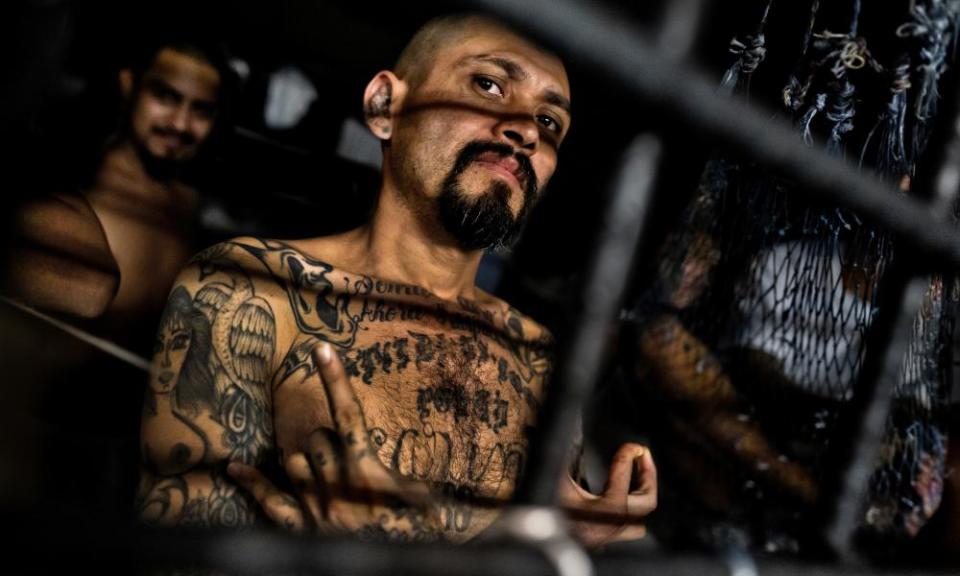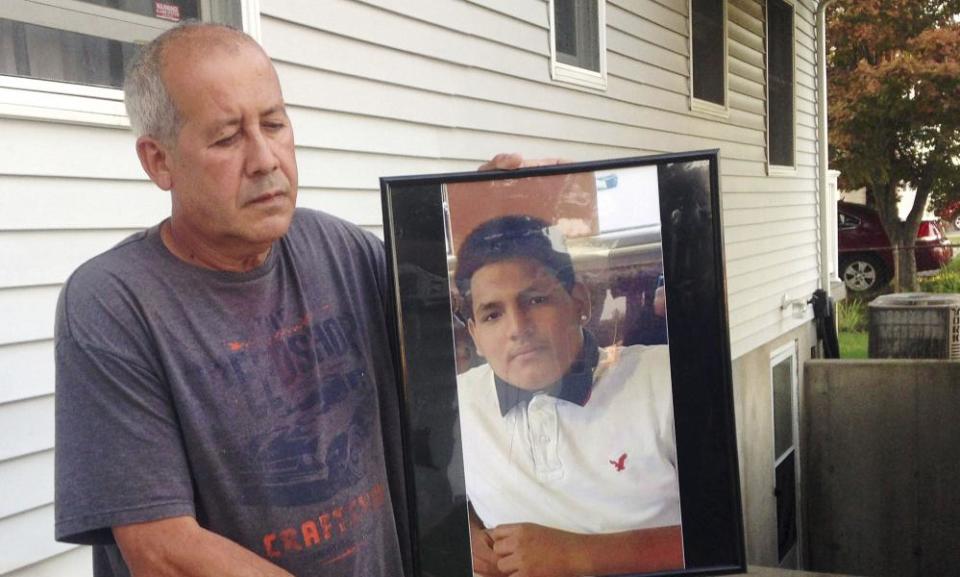MS-13 terrifies Long Island’s Latinos – and prompts a political backlash from Trump

The first victims were high school friends Nisa Mickens, 15, and Kayla Cuevas, 16 – killed as they were out on an evening walk last September. A week later, the bodies of Oscar Acosta and Miguel Garcia-Moran, both 19 and missing since the start of the year, were found near an abandoned hospital. Then, this month, four teenage boys were killed close by in a park in Central Islip, a predominantly Latino town on New York’s Long Island, 40 miles east of Manhattan.
In that incident, the killers used machetes or other sharp instruments, their grotesque handiwork betraying the cruelty and ritualism of MS-13, or the Mara Salvatrucha, a neighbourhood street gang with its roots in El Salvador’s civil war of the 80s and 90s.
While no arrests have been made in the most recent murders, police said the victims – Jorge Tigre, 18, Justin Llivicura, 16, Michael Banegas, 18, and Jefferson Villalobos, 18 – were killed in a manner “consistent with the modus operandi” of MS-13.
Now the gang’s trademark brutality and terrifying, heavily tattooed countenances have attracted the attention of US political and law enforcement leadership. On Friday, at Central Islip’s vast federal courthouse, which rises like a white edifice in scrubby woodland five miles from where the murders took place, President Trump’s attorney general, Jeff Sessions, restated his commitment to helping the police battle street gangs.
He said the killings were an assault on law and safety, vowed to not let this continue, and blamed “bad guys [that] know how the system works, and they have exploited it”.
Coming on the 100-day mark of the new presidency, Sessions’s comments sought to give flesh and bone to the “bad hombres” of Trump campaign folklore. They could hardly have found a more ferocious-looking group of young men upon which to fix their fear of the outsider.
Indeed, senior administration officials have been outdoing each other with graphic descriptions of a gang that, according to the FBI’s National Gang Intelligence Center, has 30,000 members worldwide and around 10,000 in the US.
The secretary of homeland security, John Kelly, described their supposed role in smuggling immigrants into the US as “a course north that rivals Dante’s journey into hell”.
Kelly was followed by Sessions, who said “depravity and violence are their calling cards”. He was followed by Trump, who added: “They are a bad group, and somebody said they are as bad as al-Qaida, which is a hell of a reference ... We are out in Long Island, cleaning out the MS-13 scum.”
Thus, the blue-collar communities of Central Islip and Brentwood – with their brightly decorated Spanish-language restaurants serving Salvadoreans, Guatemalans, Mexicans and other Latino communities – have become the prima facie justification for President Trump’s immigration crackdown.

It is a bitter confluence: a president, so far thwarted in his anti-immigration agenda and now looking to make a mark, coupled with a criminal gang that has spread through poor immigrant communities virtually unimpeded, many say, by law enforcement.
In a recent roundup of 13 suspected MS-13 gang members, seven had entered the US as unaccompanied minors, giving what many fear will be false justification to an administration that has been accused of trying to scapegoat immigrants in the service of a racial agenda.
“These are ugly, brutal events, so for Sessions to come in here to score political points is insulting,” said Foster Maer of campaign group LatinoJustice, who had come to the courthouse with dozens of others to protest at the attorney general’s visit. He accused Sessions of grandstanding for attention and warned that a heavy-handed, poorly targeted crackdown would serve to exacerbate a growing sense of ostracism within immigrant communities.
Maer claimed discrimination had contributed to authorities failing to heed warnings about MS-13 violence or to investigate MS-13-related activity when Latino teens began to disappear last year.
“The failure of local police to welcome the Latino community and gain their trust has created this. Law enforcement put its head in the sand when the murders started a year ago,” Maer said. “They refused to investigate. It wasn’t till two girls disappeared that they started looking.”
The young age of both the victims and perpetrators has added to the growing sense of alarm here.
Prosecutors described the killings of the two teenage girls, Mickens and Cuevas, as a homicidal overreaction to a dispute between pupils and gang members at Brentwood High School a week earlier. The four young men arrested for the girls’ murders, who are aged between 19 and 22, are believed to subsequently have been directed by MS-13 leaders to set on them with baseball bats and machetes.
Evelyn Rodriguez, Cuevas’s mother, said her daughter had been bullied for two years before she was killed. Students at the school, Rodriguez said, “can’t walk the halls without fear”.
Suffolk County’s police commissioner, Timothy Sini, said there was no question that MS-13 was recruiting children who may be unaccompanied or unsupervised. The youngsters “don’t have an established social network, at least many of them don’t, and MS-13 is providing that network,” he said.
According to local community organiser Katie Costanzo, Latino students are more likely to be expelled or suspended, making them easy marks for gang recruiters, who then demand elaborate criminal initiations. “If you’re not in school, you’re going to be on the streets. Who is going to accept you if you are on the streets? The gangs.”
Others fear that law enforcement will crack down on the community, sweeping up undocumented immigrants without effectively targeting the gang members, thereby achieving a political end without solving a crisis of criminality.

“A crackdown is not needed,” said one community organiser who did not wish to be identified. “This is going to be used to justify sweeps and mass deportation.”
MS-13, the community organiser said, were merely perpetuating the customs of extortion they practice in El Salvador and Honduras. Many of the original members of MS-13 were deported from Los Angeles in the 90s, and restored its power base in El Salvador. Authorities believe it is now sending members north to carve out new territory.
“They do what they know. If you’re part of this gang, you’re in it for life. If you come to this country, you have to seek out and find other individuals involved,” said the community organiser. But since the recent murders of the four teenagers, and the subsequent attention from outside the area, he said, “anybody they’re looking for is not here any more. They already left.”
Nonetheless, the political class is gathering with promises of firm action. New York governor Andrew Cuomo, a potential Democratic presidential candidate in 2020, also visited the area, promising “undercover work” and an expansion of an anti-gang task force.
Some of the force were in evidence last week, patrolling in unmarked cars, the seriousness of their demeanour contrasting with the vibrancy of the community and the constant musical beats coming out of storefronts. Asked how they planned to tackle MS-13, the black-clad agents in bulletproof vests said simply: “No comment.”

 Yahoo News
Yahoo News 